The vibecession is back in the headlines. The term is used to describe a disconnect between how people feel about the economy and how the economy is actually performing.
Consumer sentiment has dropped to multi-year lows, inflation expectations have surged, and markets are reacting nervously.
At the same time, spending and employment data remain strong.
The divergence between perception and reality is growing, but this time, the stakes are higher.
What happens next may depend not just on economics, but on policy and psychology.
Is the American consumer really in trouble?
The latest University of Michigan consumer sentiment index fell to 57 in March, its lowest reading in more than two years.
Expectations for the future dropped by 18% from February, the sharpest fall since 2021.
Two-thirds of Americans now expect unemployment to rise over the next year, the highest share since 2009.
Inflation expectations have jumped as well, with consumers now anticipating 5% inflation over the next year and 4.1% annually over the next 5 to 10 years.
That’s the highest long-run figure since 1993.
But nevertheless, beneath these alarming figures, the fundamentals remain surprisingly intact.
Personal consumption expenditures rose 0.4% in February, and core PCE inflation, the Federal Reserve’s preferred measure, ticked up 0.4% as well, reaching 2.8% year-over-year.
These were some good inflation readings, all things considered.
Jobless claims are low, and the labor market shows no broad-based weakness, at least outside the federal sector.
Credit card spending per household has risen 1.5% year-over-year, according to Bank of America, which shows that so far, consumers aren’t so eager to cut back on spending.
In short, the numbers don’t scream recession. But that doesn’t mean the situation is stable.
How much of this is tariffs, and how much is fear?
The renewed wave of anxiety among American consumers and investors has coincided almost perfectly with a new trade policy push from the Trump administration.
Tariffs on Chinese imports have doubled to 20%, with additional levies on cars, steel, aluminum, and other goods either in effect or expected soon.
According to the nonpartisan Tax Foundation, the proposed 2025 tariff structure could raise the effective tariff rate to 8%, the highest since the 1960s.
Estimates from the Yale Budget Lab suggest these policies could reduce average household disposable income by $2,000 per year, adjusted for inflation.
That’s not insignificant, especially when 25 to 30% of Americans already live paycheck to paycheck.
But the economic impact is not just direct. The anticipation of higher prices and the media coverage surrounding it may be shaping behaviour even before tariffs take full effect.
Consumer sentiment often falls before actual spending does. If enough people believe inflation will rise and jobs will be lost, their spending decisions may turn those fears into reality.
Is this how stagflation begins?
The term stagflation refers to the toxic combination of slow growth and high inflation.
It was rare before the 1970s but has since become shorthand for a worst-case scenario in macroeconomics.
Some economists are now warning that the current conditions fit the early shape of stagflation.
Core inflation has accelerated for four consecutive months. Real consumer spending is losing momentum.
Imports are surging ahead of expected tariffs, which may weigh on GDP.
Goldman Sachs recently cut its forecast for first-quarter GDP growth to 0.6%, down from 1%.
The Atlanta Fed’s GDPNow model has gone further, projecting a 0.5% contraction.
Meanwhile, core PCE inflation over the past three months is running at a 3.6% annualized pace, the highest since March 2024.
If inflation stays hot and growth turns negative, the Fed will be stuck between two hard options: raise rates and deepen the slowdown, or hold and let inflation linger.
Can consumer resilience hold the line?
Liquid assets among households remain high compared to pre-pandemic levels.
Air travel has rebounded to 2024 levels, and spending on durable goods like cars and electronics has picked up after a weak January.
Tax refunds are up more than 5% year-over-year, which could give short-term support to retail and discretionary spending in April.
However, some of this strength may be temporary or overstated. Much of the February income boost came from government benefits.
Discretionary service spending, such as at restaurants and hotels, fell sharply in February.
Consumers may still be spending, but they are becoming more cautious about where and how. This is the kind of behavior that often signals a turning point.
What if perception is reality?
The current reality is that most of the published data we now have in our hands is lagging.
Most of the Trump administration policies haven’t yet gone into effect, therefore, their real impact cannot yet be seen or calculated.
But economics is not just about numbers. When a large enough share of the population believes the economy is worsening, it changes how people act. That, in turn, affects the actual economy.
This is the essence of the vibecession: the belief in decline becomes a self-fulfilling prophecy.
But the problem now is more structural. The public’s inflation expectations have detached from central bank targets, and their confidence in the future has collapsed across income, political, and demographic groups.
Even high-income households, which are typically more optimistic, are now pulling back on spending.
If this becomes entrenched, it could force the Federal Reserve to choose between short-term stability and long-term credibility.
For now, the hard data suggests the economy is still growing, albeit slowly, but public confidence is unraveling, while consumers and investors are anxious.
That gap cannot hold forever. Either sentiment will recover, or reality will catch up to the mood.
The coming months will reveal which side bends first.
The post Is the “vibecession” back? Here’s what the data really says appeared first on Invezz

